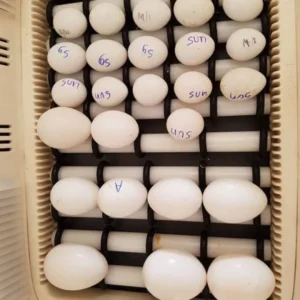Added Advantage to Beginners;
We will ship your order long with a hatching guide. That will assist you throughout the process of Hatching, Feeding, and Raising the babies.
A clutch of twelve eggs, for example, would take the hen 15 days to lay. Cockatoo chicks begin hatching after a 21-day period. Accordingly, one egg will hatch every other day, each one taking 21 days from the beginning of its incubation. Both parents remove eggshell bits and clean the hatch-lings.
What temperature should parrot eggs incubate at?
Incubate the eggs in an incubator designed for a parrot or exotic bird eggs. The incubator you use should have accurate temperature control within one-tenth of one degree, and ideally a system for humidity control. Maintain the temperature at 99.3 degrees F, and the humidity at 40 to 50 percent.
How long does it take for a parrot egg to hatch?
Incubation Duration. Parrot egg incubation periods can vary by breed but are typically between 24-28 days. Some parrot breeds can hatch in as little as 18 days. Research your specific breed to find out how long your egg will need to be incubated.
Turn the eggs to a new position once daily until placing it in the incubator. Hatchability holds reasonably well up to 3 weeks. Therefore, do not store eggs for more than 3 weeks before incubating.
Descrption
Cockatoos are of the 21 species of parrots belonging to the family Cacatuidae, the only family in the superfamily Cacatuoidea. Along with the Psittacoidea (true parrots) and the Strigopoidea (large New Zealand parrots), they make up the order Psittaciformes. The family has a mainly Australasian distribution, ranging from the Philippines and the eastern Indonesian islands of Wallacea to New Guinea, the Solomon Islands and Australia.
Genera and species
There are about 44 different birds in the cockatoo family Cacatuidae including recognized subspecies. The current subdivision of this family is as indicated on our website.
Behaviour
Cockatoos are diurnal and require daylight to find their food. They are not early risers, instead waiting until the sun has warmed their roosting sites before feeding. All species are generally highly social and roost, forage and travel in colourful and noisy flocks. These vary in size depending on availability of food; in times of plenty, flocks are small and number a hundred birds or less, while in droughts or other times of adversity, they may swell up to contain thousands or even tens of thousands of birds; one record from the Kimberley noted a flock of 32,000 little corellas.
Breeding
Cockatoos are monogamous breeders, with pair bonds that can last many years. Many birds pair up in flocks before they reach sexual maturity and delay breeding for a year at least. Females breed for the first time anywhere from three to seven years of age and males are often older.
Diet and feeding
Cockatoos are versatile feeders and consume a range of mainly vegetable food items. Seeds form a large part of the diet of all species; these are opened with their large and powerful bills. The galahs, corellas and some of the black cockatoos feed primarily on the ground; others feed mostly in trees.
Social learning
Cockatoos have been shown to learn new skills through social interaction. In New South Wales, researchers and citizen scientists were able to track the spread of lid-flipping skills as cockatoos learned from each other to open garbage bins.






Reviews
There are no reviews yet.